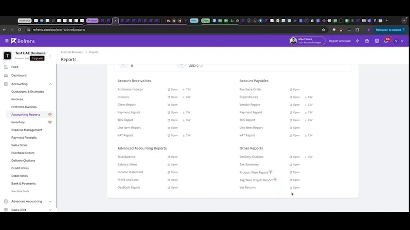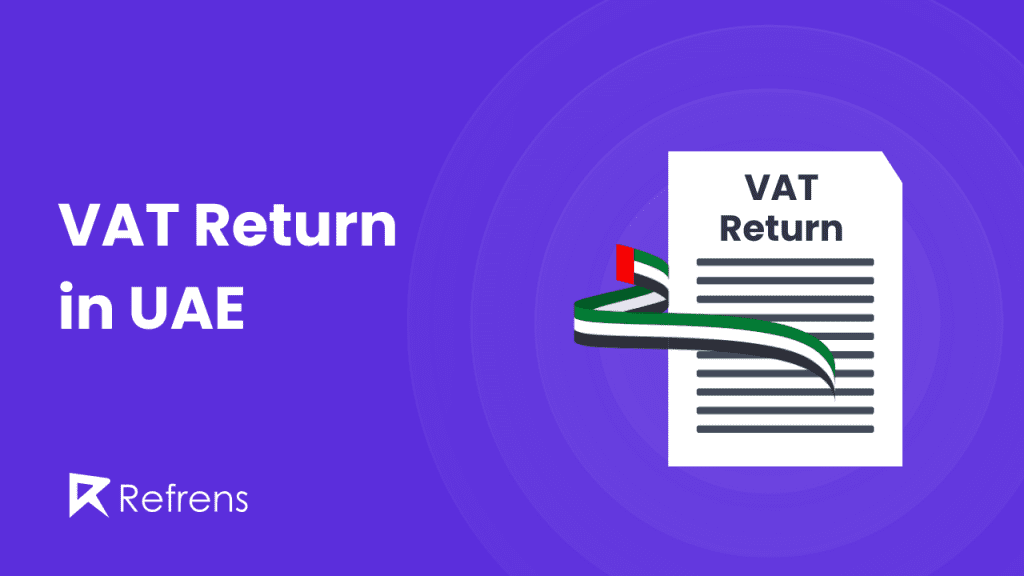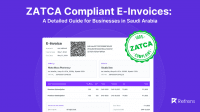Value-added Tax (VAT) was introduced in the UAE on January 1, 2018, at a standard rate of 5%. It is an indirect tax applied to most goods and services, collected by businesses at each stage of the supply chain and ultimately paid by the end consumer. The introduction of VAT aims to diversify the UAE’s revenue sources and align with global tax practices.
VAT applies broadly across various sectors, with certain exemptions for specific industries like healthcare and education. This tax system provides a stable revenue stream for the government to enhance public services and promotes greater transparency and accountability in business operations.
Importance of Filing VAT Returns
Filing VAT returns is a crucial legal obligation for VAT-registered businesses in the UAE. A VAT return is a document submitted to the Federal Tax Authority (FTA), detailing the VAT collected on sales (output VAT) and the VAT paid on purchases (input VAT). Filing these returns accurately and on time is essential for several reasons:
- Legal Compliance: Under UAE law, filing VAT returns is mandatory. Non-compliance can result in hefty fines, penalties, audits, and even suspension of a business’s trade license.
- Financial Management: Accurate VAT filings help businesses maintain precise financial records, manage cash flow, and make informed decisions by regularly reconciling their accounts.
- VAT Refunds: If a business pays more VAT on purchases than it collects on sales, the government can refund it. This refund helps improve cash flow and provides funds for further investment.
- Avoiding Penalties: Timely and correct filings help avoid significant fines and penalties imposed by the FTA for non-compliance, ensuring that businesses remain in good legal standing.
- Credibility and Trust: Consistent compliance with VAT regulations builds trust with customers, suppliers, and investors, enhancing the business’s reputation.
Who Must File a VAT Return in the UAE?
Understanding who is required to file a VAT return is essential for businesses to stay compliant with UAE tax laws. Filing VAT returns is mandatory for businesses that meet certain thresholds and criteria set by the Federal Tax Authority (FTA).
Businesses Required to Register and File VAT Returns
In the UAE, businesses that make taxable supplies of goods and services must register for VAT and file VAT returns. Taxable supplies include the sale of goods or services subject to VAT at either the standard rate (5%) or zero rate (0%). Both mainland and eligible free zone businesses are required to comply if they meet the registration criteria.
Businesses Required to File VAT Returns
- Taxable Persons: Any individual, partnership, company, or entity conducting business in the UAE must register and file VAT returns if they exceed the VAT registration threshold.
- Importers: Businesses that import goods into the UAE must register for VAT and file returns to account for the VAT due on their imports.
- Voluntary Registrants: Businesses that do not meet the mandatory registration threshold but exceed the voluntary threshold can register for VAT voluntarily. These businesses are also required to file VAT returns.
Filing Thresholds and Criteria
The FTA has set specific thresholds to determine if a business must register for VAT:
- Mandatory Registration Threshold: Businesses must register for VAT if their taxable turnover exceeds AED 375,000 over the previous 12 months or is expected to exceed this amount in the next 30 days. Taxable turnover includes all taxable supplies, imports, and exports, excluding exempt supplies.
- Voluntary Registration Threshold: Businesses can choose to register voluntarily if their taxable turnover or expenses exceed AED 187,500 in the previous 12 months. This is beneficial for smaller businesses that want to recover input VAT on their expenses.
- Exemptions from Registration: Businesses that only supply VAT-exempt goods or services (like certain financial services or residential rentals) do not need to register for VAT and are not required to file VAT returns.
Importance of Registering and Filing VAT Returns
Registering for VAT and filing returns ensures businesses comply with UAE tax laws, avoid penalties, and maintain their reputation. It also allows businesses to claim input VAT on their expenses, potentially reducing their tax liability. Understanding the registration criteria helps businesses manage their tax obligations efficiently and remain compliant.
VAT Return Filing Deadlines in the UAE
VAT-registered businesses in the UAE must adhere to specific deadlines for filing VAT returns, which vary depending on whether they file quarterly or monthly. Missing these deadlines can result in penalties. Here’s a concise overview:
Quarterly Filing Periods
Most businesses file VAT returns quarterly. Here are the key periods and deadlines:
- Q1 (Jan-Mar): File by April 28th
- Q2 (Apr-Jun): File by July 28th
- Q3 (Jul-Sep): File by October 28th
- Q4 (Oct-Dec): File by January 28th of the following year
Monthly Filing Periods
Businesses with higher turnovers or those opting for monthly filing must submit returns more frequently:
- Every Month: File by the 28th of the following month
(e.g., January’s return is due by February 28th)
Key Reminders
- Submit Returns Electronically: All returns must be filed via the FTA’s e-services portal.
- Pay VAT on Time: VAT payments are due on the same date as the filing deadline to avoid penalties.
- Penalties for Late Filing: Starting at AED 1,000 for the first offense and increasing if repeated.
Stay organized by setting reminders, preparing in advance, and considering accounting software to manage filings efficiently.
Preparing for Your VAT Return: A Quick Guide
Filing a VAT return in the UAE requires careful preparation to ensure compliance and avoid penalties. Here’s a concise overview to help you prepare effectively:
1. Required Documents and Records
To file your VAT return, you need:
- Sales Invoices: Detailing all sales and VAT charged.
- Purchase Invoices: For all purchases where VAT was paid.
- Credit/Debit Notes: For any adjustments to original invoices.
- Expense Receipts: For VAT-inclusive business expenses.
- Bank Statements: To verify payments and transactions.
- Accounting Records: Including ledgers and financial statements.
- VAT Return Summaries: Showing total output VAT (sales) and input VAT (purchases).
2. Calculating VAT Payable and Reclaimable
- Output VAT: Sum of VAT charged on sales.
- Input VAT: Sum of VAT paid on business-related purchases.
- Net VAT: Subtract input VAT from output VAT to determine if you owe VAT or can reclaim it.
- Positive Net VAT: Payable to the FTA.
- Negative Net VAT: Reclaimable or can be carried forward.
3. Tips for Accurate VAT Calculations
- Apply Correct VAT Rates: Use the correct VAT rate (standard, zero-rated, or exempt) for all transactions.
- Adjust for Notes: Include any credit or debit notes that impact VAT amounts.
- Review Transactions: Regular checks ensure all entries are accurate.
- Use VAT Software: Automates calculations and reduces errors.
4. Submitting Your VAT Return
- Access FTA e-Services Portal: Log in and navigate to the VAT section.
- Complete the Form: Enter all figures accurately.
- Submit and Pay: Submit the form and pay any VAT due by the deadline.
5. Final Tips
- Stay Organized: Keep all documents and records easily accessible.
- Set Reminders: Ensure timely filing to avoid penalties.
- Consult a Tax Expert: Seek advice if unsure about any aspect of your VAT return.
Following these steps will help you prepare and file your VAT return accurately and on time.
Steps to File a VAT Return in the UAE
1. Accessing the FTA Portal
- Log In: Begin by visiting the Federal Tax Authority’s official website at www.tax.gov.ae. Use your registered credentials to log into your account.
- Navigate to VAT: In the VAT section, select “VAT201 – VAT Return” to open your VAT return form.
- Update Information: Make sure that your business details and VAT registration number are up-to-date and accurate.
2. Filling Out the VAT Return Form
- Taxable Supplies: Enter all taxable supplies, distinguishing between those that are standard-rated and those that are zero-rated.
- Exempt Supplies: Input the value of supplies that are exempt from VAT as these do not require VAT to be paid.
- Imports: Report the value of goods imported into the UAE, which will have VAT calculated automatically by the system.
- Recoverable VAT: Detail the VAT you can reclaim from business expenses and eligible imports.
- Net VAT Due Review the total VAT due or refundable as calculated by the system.
3. Submitting the VAT Return
- Review and Submit: Carefully review all the information entered for accuracy before submitting your VAT return.
- Payment: Complete the payment for any VAT due using the specified online payment methods before the due deadline.
4. Post-Submission Steps
- Save Confirmation: Ensure you save or print a copy of the submission receipt for your records.
- Monitor Notifications: Regularly check your email and FTA portal for any communications or notifications regarding your VAT return.
This detailed guide, supplemented by informative video tutorials, offers a comprehensive understanding of each step in the VAT return filing process in the UAE.
Common VAT Filing Mistakes and How to Avoid Them
Filing VAT returns accurately and on time is crucial for businesses in the UAE to maintain compliance and avoid penalties. Here are some common mistakes and tips to avoid them:
1. Calculation Errors
Mistakes in calculating VAT can lead to incorrect returns. These errors often occur due to incorrect VAT rates, mistakes in sales or purchase amounts, or not accounting for the reverse charge mechanism properly.
Tips to Avoid Calculation Errors:
- Use VAT-compliant accounting software to automate calculations.
- Regularly reconcile VAT reports with your sales and purchase records.
- Stay updated on VAT rules and regulations.
2. Late Submissions
Missing the VAT return filing deadlines can result in hefty penalties. Delays often happen due to a lack of awareness about deadlines, last-minute preparations, or overlooking payment deadlines.
Tips for Timely Submissions:
- Set reminders for all key VAT deadlines.
- Prepare your VAT returns well in advance.
- Utilize automated filing systems to manage deadlines efficiently.
3. Poor Record Keeping
Inadequate documentation can lead to errors in VAT filings. Common issues include missing records, insufficient supporting documents, and not correcting past errors.
Tips to Improve Record Keeping:
- Maintain accurate and detailed records of all transactions.
- Ensure all required documents are attached to your VAT returns.
- Regularly audit your VAT-related documents for compliance.
4. Mistakes with Imports and Exports
Errors in handling VAT for imports and exports, such as incorrect application of zero-rated VAT or not accounting for import VAT properly, are common.
Tips to Manage Import and Export VAT:
- Understand the VAT rules specific to cross-border transactions.
- Consider consulting a VAT specialist for complex transactions.
By being aware of these common mistakes and taking proactive steps to avoid them, businesses can ensure smoother VAT return processes and maintain compliance with UAE tax laws.
Correcting Errors and Amendments in VAT Returns
1. Identifying Errors in Previous Returns
Before making any corrections, it is essential to identify the nature and extent of the errors in the VAT returns. Common errors may include:
- Incorrect VAT Calculations: Errors in calculating the VAT amount due or recoverable.
- Incorrect Classification of Goods or Services: Misclassifying taxable, exempt, or zero-rated supplies.
- Incorrect Details Provided: Errors in the information provided, such as incorrect client details or invoice numbers.
- Omissions: Failing to include certain transactions that should have been declared.
2. Making Adjustments through the FTA
Once an error is identified, businesses must make the necessary corrections. The FTA provides a structured process for handling these amendments:
- Minor Errors: If the error in the VAT return results in a difference of AED 10,000 or less, it can be adjusted in the subsequent VAT return. The adjustment must be documented and justified to avoid future issues.
- Major Errors: For errors exceeding AED 10,000, businesses must submit a Voluntary Disclosure through the FTA’s e-Services portal. A Voluntary Disclosure form (VAT Voluntary Disclosure Form 211) must be completed, detailing the nature of the error, the period it pertains to, and the correct amount of VAT due or recoverable.
3. Steps to Correct Errors in VAT Returns
To correct errors or make amendments, businesses should follow these steps:
- Log in to the FTA e-Services Portal: Access your business account on the FTA website.
- Access the Voluntary Disclosure Form: Navigate to the ‘VAT’ section and select ‘VAT Voluntary Disclosure.’ This form is used for reporting errors that exceed AED 10,000.
- Complete the Form: Provide all required information, including the tax period in question, details of the error, and the corrected amounts.
- Submit Supporting Documents: Attach any necessary documentation that supports the correction, such as revised invoices or receipts.
- Review and Submit: Carefully review the form for accuracy and completeness before submitting it.
- Await FTA Review: Once submitted, the FTA will review the disclosure and may request additional information or clarification. It is crucial to respond promptly to any requests from the FTA to avoid delays.
4. Avoiding Penalties
To avoid penalties for errors in VAT returns, businesses should:
- Maintain Accurate Records: Keep detailed and accurate records of all transactions, including sales, purchases, and VAT calculations.
- Regularly Review Returns: Periodically review VAT returns and transactions to identify and rectify errors before submission.
- Consult a Tax Advisor: Regular consultations with a tax advisor can help identify potential issues and ensure compliance with FTA regulations.
5. Penalties for Errors
Failing to correct errors or making incorrect amendments can result in penalties:
- Fixed Penalty: AED 3,000 for the first violation and AED 5,000 for subsequent violations.
- Percentage-Based Penalty: Up to 50% of the unpaid tax due, depending on the circumstances and whether the error was self-reported or discovered by the FTA.
By understanding and following the correct procedures for correcting errors and amendments in VAT returns, UAE businesses can ensure compliance with tax regulations and avoid unnecessary penalties.
Tips for Effective VAT Management
Effective VAT management is crucial for UAE businesses to remain compliant and avoid penalties. Here are some key strategies:
1. Keep Accurate Records
- Document All Transactions: Maintain detailed records of all sales, purchases, invoices, and receipts, showing the VAT charged or paid.
- Organize Supporting Documents: Store contracts, bank statements, and delivery notes in an organized manner.
- Update Records Regularly: Keep records up-to-date to avoid errors and simplify VAT return filing.
- Retain Records for 5 Years: UAE law requires businesses to keep VAT records for at least five years.
2. Use Software Tools for Compliance
- Automate VAT Calculations: Use accounting software to automatically calculate VAT on transactions.
- Generate VAT-Compliant Invoices: Ensure invoices include all necessary details such as VAT registration numbers and VAT amounts.
- Simplify VAT Return Filing: Choose software that facilitates easy preparation and filing of VAT returns.
- Manage Multiple Currencies: Use software that supports multiple currencies for businesses dealing with international clients.
- Monitor VAT Payments: Track VAT liabilities and set reminders for filing deadlines to avoid late submissions.
3. Regularly Review VAT Processes
- Conduct Internal Audits: Regular audits help identify discrepancies and ensure compliance.
- Stay Updated on Regulations: Keep up with changes in UAE VAT laws to maintain compliance.
- Train Staff: Regularly train your team on VAT requirements and software usage.
By implementing these strategies, businesses can streamline VAT management and avoid potential penalties.
Complying with VAT laws is more than just a legal obligation; it is crucial for preserving a strong business reputation, ensuring financial stability, and building trust with customers, suppliers, and investors.
By being organized, informed, and proactive in managing VAT, businesses can avoid penalties, improve efficiency, and support economic growth in the UAE.
Generate VAT Return Reports in Seconds!
Refrens is a versatile cloud-based accounting software designed to streamline financial management for businesses of all sizes. Used by over 150,000 businesses across 178 countries, it offers a comprehensive suite of tools, including invoicing, accounting, inventory tracking, expense management, and client and vendor management—all in one platform.
Refrens allows users to easily create and manage financial documents like invoices, purchase orders, and more. Its user-friendly interface simplifies accounting and ensures compliance, making it perfect for UAE businesses.
Refrens automatically generates VAT reports by processing all sales and purchase transactions entered into the system. It calculates VAT based on the applicable tax rates for each transaction and organizes them into categories like standard-rated, zero-rated, exempt, and reverse charge.

The software updates the VAT report in real-time as transactions are added or changed, ensuring businesses always have an accurate VAT return ready for download. This automation simplifies compliance, minimizes errors, and eliminates the need for manual calculations.



















